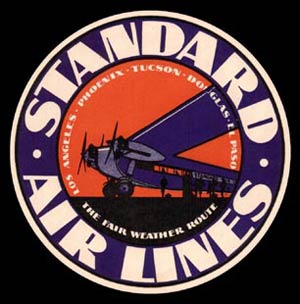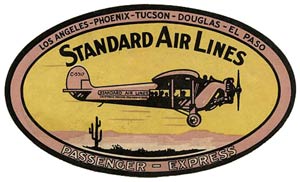|
INCOMPLETE
There were 328 landings (288 by civilian; 40 by military pilots) by Fokker aircraft at Tucson during the period of the Register, 1925-1936. Civilian arrivals were in 25 unique airplanes, while military pilots landed in 17 unique craft. Most of the civilian landings were the result of the activity of a single airline company, Standard Air Lines (PDF 670KB), flying four different early transport aircraft, NC3317 (landed 95 times), NC8011 (81 landings) and NC9724 (57 landings).
There were another 186 landings by Fokker aircraft at the Grand Central Air Terminal, Glendale, CA during 1930-31. And 52 at Oxnard Field, Albuquerque, NM and 147 at Peterson Field, Pitcairn Field, Parks Airport and Clover Field combined. Fokker comprised a significant share of all landings at all airfields during the Golden Age.
NC7888 is the "Texan" of Standard Airlines. This aircraft crashed in fog near Beaumont, CA two months to the day after it landed at Tucson (March 30, 1929), killing three passengers and the pilot. See the link for details. The two people in the photograph at the link appear to be servicing the engine oil, a never-ending job for these aircraft.
For access to the dozen or so models of Fokkers that landed at any airfield, go to the AIRPLANES button at the upper right of any home page and choose to search the database "by plane type and model". Then choose "Fokker" from the drop down menu.
Among the pilots celebrated on this site who flew Fokker aircraft are Eddie Brooks, F. Trubee Davison, Felix duPont, Ira Eaker, Jack Frye, Harold Kelsey, Lake Littlejohn, Lester Maitland, John Martin, Paul Richter, Hap Russell, C.N. Shelton, Lee Willey and Carl Spatz, among others.
A view of the Fokker factory with three new F-10 ("A" models, because of the exhaust pipe design?) transport aircraft parked on the ramp, is below, and on the NASM site. Cash value of the aircraft you see in the photograph is 3 X $67,500. Today you could barely purchase a low-end, certificated, single-engine personal aircraft for that total sum.
Fokker Factory, Date Unknown
(Source: NASM)
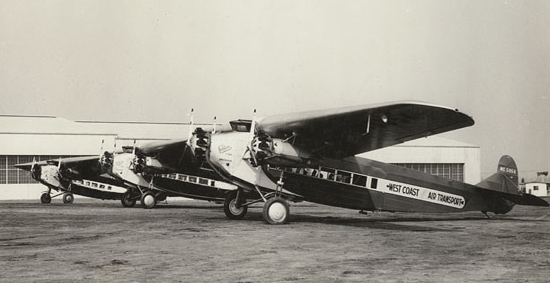 |
Mr. & Mrs. Anthony Fokker visited Tucson at least once. They are recorded in the Register on Friday, June 22, 1928, flying with pilot Thomas J. Fowler in Fokker F-10 NC5614. They were traveling eastbound
from Los
Angeles, CA to Chicago,
IL.
---o0o---
This 2005 film link is a 51.5-minute history of Fokker aircraft beginning about 1911. About the first third of this film concerns Golden Age aircraft, including some Fokker models that landed at Tucson.
The first two minutes of the video are introductory, then the history begins with:
1920: We see Anthony Fokker talking with aircraft people (KLM). We see engines of the Fokker FVIIA being started with hand cranks.
1927: At 4 minutes: 12 seconds we see the first executive FVII. Note, just briefly, the huge load of sod being dragged along by the tail skid of this airplane as it taxis to the ramp. At 6:31 there is a good shot of a well-coordinated landing by this airplane.
1930: Beginning at 9:30 we see the FVIII with Dutch children filing into the airplane. We see interior views of the cabin, as well as views of the takeoff and aerial views of the Fokker facility.
1932: Beginning at 11:34 we see the FXII with sound. Good aircraft details are shown, including the wheel pants of formed metal. We see another cranked engine start and another good takeoff.
1934: Beginning at 13:20 we see the four-engine FXXXVI with sound.
1936: Beginning at 15:00 we see views of the 25-year Fokker Jubilee. Fokker speaks at 15:50.
1940: Beginning at 16:42 we see the Fokker S11. There is then a gap during WWII.
1950: Beginning at 18:48 we switch to color and full sound. We see the F27 and beyond, including contract work on the Airbus, F-16 modifications, space and robots.
At the very end of the video is an airborne facsimile flight of a Fokker C-2 mlitary transport painted in the livery of the "Question Mark" (28-120).
---o0o---
A CONJECTURE OVER COLORATION
Color film, or color photographic images of any kind, were not practical at the time most Register airplanes flew into Tucson. It's difficult, therefore, in the absence of color paintings or written color data, to know the colors these aircraft wore during their day to day duties. Below, for example, are versions of livery colors for the fleet of Fokker aircraft flown by Standard Air Lines in and out of Tucson between 1928 and 1930.
Thanks to Burt Cosgrove, III, contributor of THE CORNELIUS BURTON COSGROVE, JR. PHOTOGRAPH AND DOCUMENT COLLECTION to this site, we have some suggestions about the color scheme of Standard Air Lines Fokkers. Below are three views with color annotations contributed by him on July 31, 2008. If these colors are accurate, these were very attractive airplanes.
View of Standard Air Lines Fokker Liner Showing Color Scheme (Source: Cosgrove)
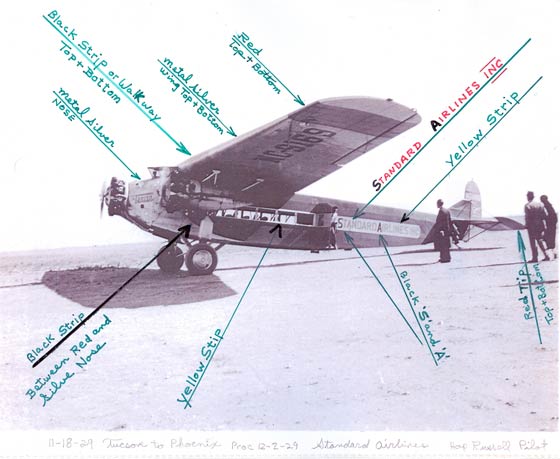 |
This airplane, The F-10A NC9169 is not signed in the Davis-Monthan Register. Below, C.B. Cosgrove, Jr. is on the left in this photograph dated November 18, 1929. He was the source of many of the original photographs at the Cosgrove Collection link, above. The pilot, with hat in hand, is Hap Russell. Cosgrove's grandmother stands in the doorway, and his mother is at far right. Compare this photo with the one above. We could easily see Cosgrove and one of the women approaching from the right; Russell opening the cabin door. The tall gentleman near the empennage looks like Jack Frye.
View of Standard Air Lines Fokker Liner Showing Color Scheme (Source: Cosgrove)
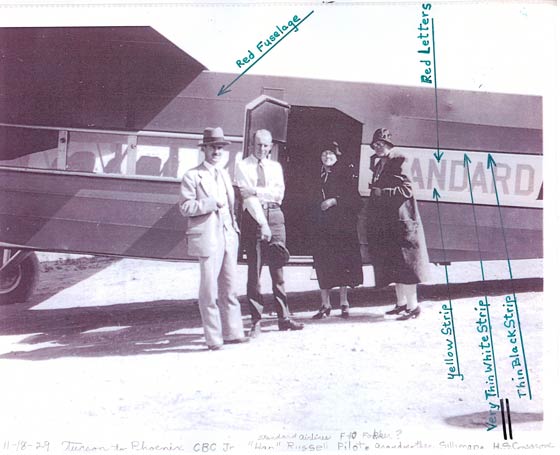 |
View of Standard Air Lines Fokker Liner Showing Color Scheme (Source: Cosgrove)
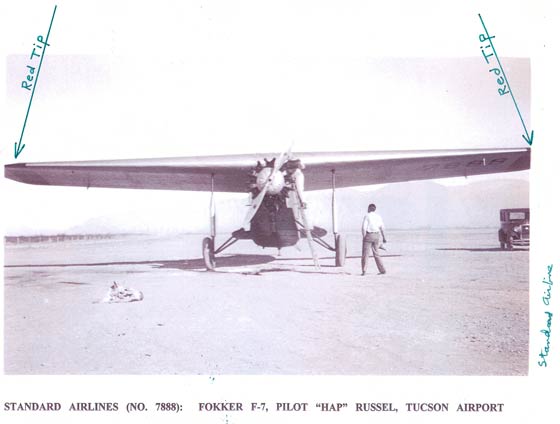 |
Below, Super Universal NC8011 painted in the color scheme suggested above.
SAL Color Model, NC8011 (Source: Cosgrove)
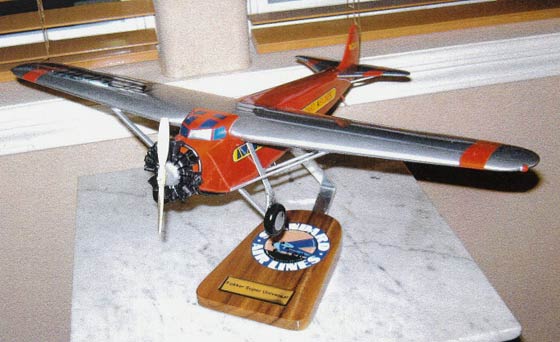 |
We have a second opinion of the Standard Air Lines color scheme. As stated by Roger Holden, "Although no one can claim to be an expert in the black art of b/w photo interpretation, I feel I have a better idea than most and although some things leave me completely stumped, there are also some I'm fairly sure about, which is the case with the Standard photos." A COLOR (!) motion picture of NC3317 is at the link (YouTube video). This is an early (1928-29) example of color film technology. The airplane appears at 5:00 minutes into the film. Allowing for color renditions by the films of the day, the fuselage shows up as a shade of green and the "S" in "Standard" is red.
And further, "I'm afraid, I simply don't agree with the colours ... on those Standard Fokkers. I'm 99% sure the fuselage colour is dark blue; definitely not red. The baggage label [right, of the F-10] shows blue and I have the NACA circular on the Fokker Universal,which shows a Standard plane and (unusually) describes the colour scheme: Royal Blue and Silver with black nose panels. The pinstripe trim on the planes and the wing stripes are red. I agree with you that the fuselage lettering appears different than the basic fuselage colour; possibly gold, along with the aircraft name on the nose. That is the only part of the colour scheme I'm not certain about.
"The basic blue/red/silver colours are entirely consistent with the ortho film used. There's no way the fuselage could be red with a yellow stripe, as this would look entirely black in an ortho photo. I also consider it unlikely that they would also use a red colour scheme similar to competitor Western Air Express."
There are baggage labels, and there are baggage labels. The one at left, depicting the Universal NC3317, doesn't give much clue about the possible color of the aircraft.
To add another iron to this fire, an online video at the link shows color footage of NC3317 taken in 1928-29. The airplane appears at 5:00 minutes into the film. Allowing for color renditions by the films of the day, the fuselage shows up as a shade of greenish blue and the "S" in "Standard" is red. Perhaps the color scheme varied plane to plane, but this film and its color rendering flies in the face of the colors suggested by Mr. Cosgrove, above, and supports the comments by Mr. Holden. Regardless of the true colors, in the film we see NC3317 in motion, and we see Register pilot Ruth Elder emerge from it modeling a coat with gold buttons. She is also featured modeling another garment at 3:00.
Friend of dmairfield.org, Tim Kalina, says further, "It is a unusual for a [NACA] Circular to state specific airline colors but they have done so for the Standard Air Lines Fokker Universal. So when NACA states these colors as 'Royal blue and silver, with black nose panels' I trust the accuracy.
"Now, whether Standard's other Fokkers were painted the same I can't say for certain but it would make sense that they were. And photo evidence seems to bear this out. The model of the [Super] Universal is off on the nose color for sure. The nose should be black, a standard Universal feature and plainly seen on all Standard Air Lines Universals."
BACK TO TOP
---o0o---
Dossier 3.1.42
THIS PAGE UPLOADED: 12/02/08 REVISED: 02/06/09, 01/30/10, 03/22/12
|






